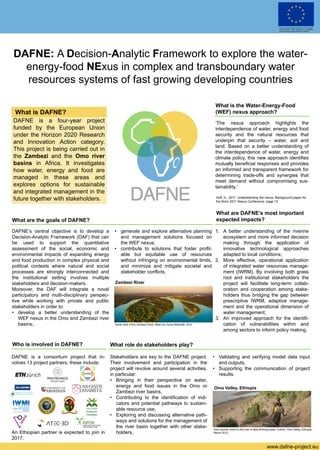A Decision-Analytic Framework to explore the waterenergy-food NExus in complex and transboundary water resources systems of fast growing developing countries
- 1. . DAFNE: A Decision-Analytic Framework to explore the water- energy-food NExus in complex and transboundary water resources systems of fast growing developing countries www.dafne-project.eu What is DAFNE? DAFNE is a four-year project funded by the European Union under the Horizon 2020 Research and Innovation Action category. This project is being carried out in the Zambezi and the Omo river basins in Africa. It investigates how water, energy and food are managed in these areas and explores options for sustainable and integrated management in the future together with stakeholders. What is the Water-Energy-Food (WEF) nexus approach? What are the goals of DAFNE? ŌĆśThe nexus approach highlights the interdependence of water, energy and food security and the natural resources that underpin that security ŌĆō water, soil and land. Based on a better understanding of the interdependence of water, energy and climate policy, this new approach identifies mutually beneficial responses and provides an informed and transparent framework for determining trade-offs and synergies that meet demand without compromising sus- tainability.ŌĆÖ DAFNEŌĆÖs central objective is to develop a Decision-Analytic Framework (DAF) that can be used to support the quantitative assessment of the social, economic and environmental impacts of expanding energy and food production in complex physical and political contexts where natural and social processes are strongly interconnected and the institutional setting involves multiple stakeholders and decision-makers. Moreover, the DAF will integrate a novel participatory and multi-disciplinary perspec- tive while working with private and public stakeholders in order to: ŌĆó develop a better understanding of the WEF nexus in the Omo and Zambezi river basins; ŌĆó generate and explore alternative planning and management solutions focused on the WEF nexus; ŌĆó contribute to solutions that foster profit- able but equitable use of resources without infringing on environmental limits, and minimize and mitigate societal and stakeholder conflicts. What role do stakeholders play? Hoff, H., 2011. Understanding the nexus: Background paper for the Bonn 2011 Nexus Conference, page 13. Stakeholders are key to the DAFNE project. Their involvement and participation in the project will revolve around several activities, in particular: ŌĆó Bringing in their perspective on water, energy and food issues in the Omo or Zambezi river basins, ŌĆó Contributing to the identification of indi- cators and potential pathways to sustain- able resource use, ŌĆó Exploring and discussing alternative path- ways and solutions for the management of the river basin together with other stake- holders, ŌĆó Validating and verifying model data input and outputs, ŌĆó Supporting the communication of project results. Aerial view of the Zambezi River, Mosi-Oa-Tunya Waterfall, 2012. Zambezi River Karo woman down to the river to take drinking water, Colcho, Omo Valley, Ethiopia, March 2012. Omo Valley, Ethiopia What are DAFNEŌĆÖs most important expected impacts? 1. A better understanding of the riverine ecosystem and more informed decision making through the application of innovative technological approaches adapted to local conditions; 2. More effective, operational application of integrated water resources manage- ment (IWRM). By involving both grass root and institutional stakeholders the project will facilitate long-term collab- oration and cooperation among stake- holders thus bridging the gap between prescriptive IWRM, adaptive manage- ment and the operational dimension of water management; 3. An improved approach for the identifi- cation of vulnerabilities within and among sectors to inform policy making. Who is involved in DAFNE? DAFNE is a consortium project that in- volves 13 project partners, these include: An Ethiopian partner is expected to join in 2017. This project has received funding from the European UnionŌĆÖs Horizon 2020 research and innovation programme under grant agreement No 690268.

